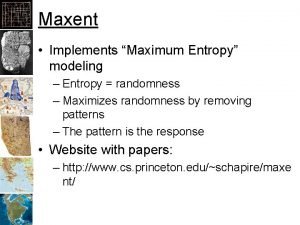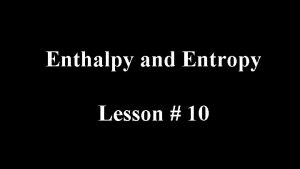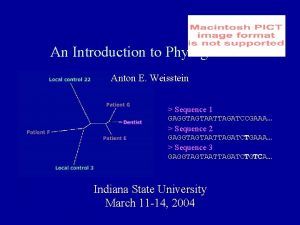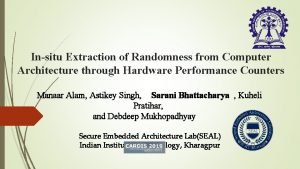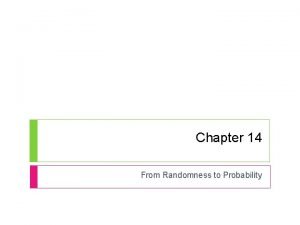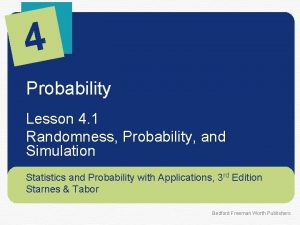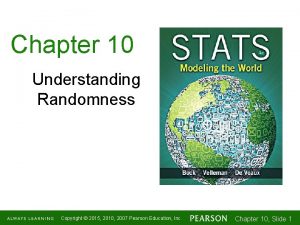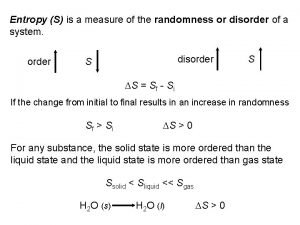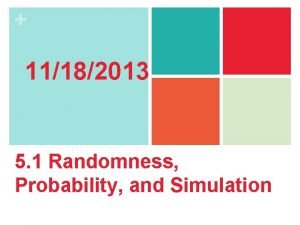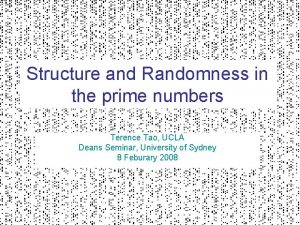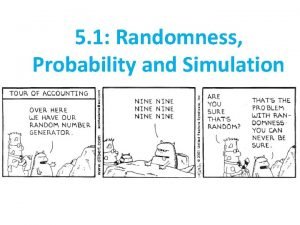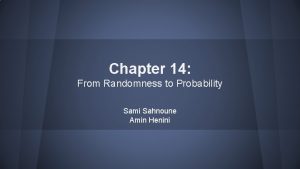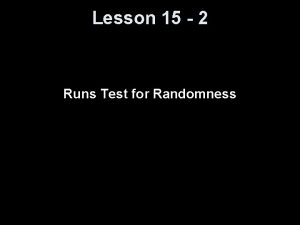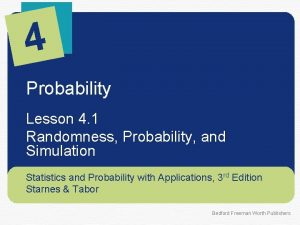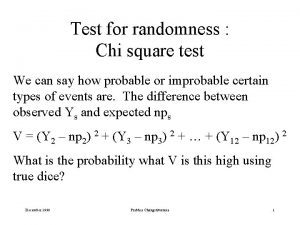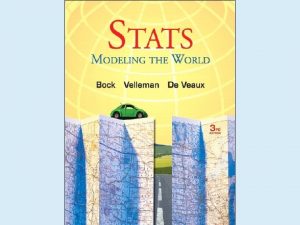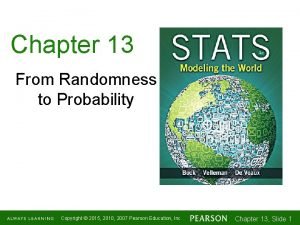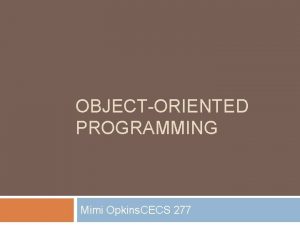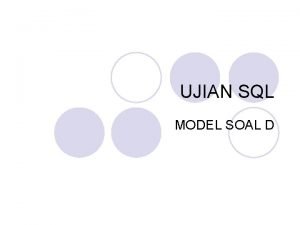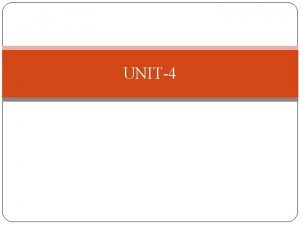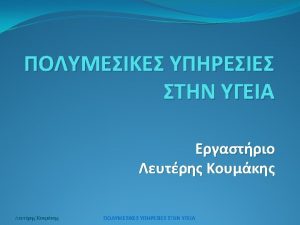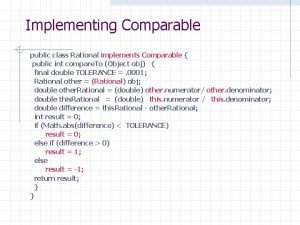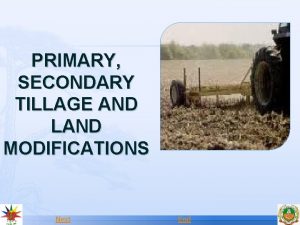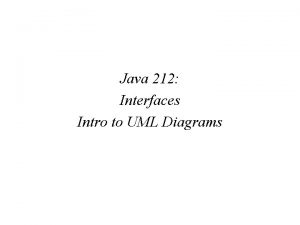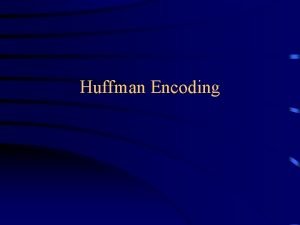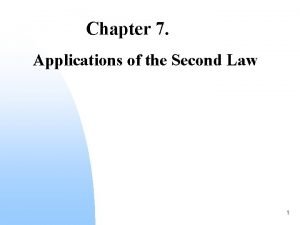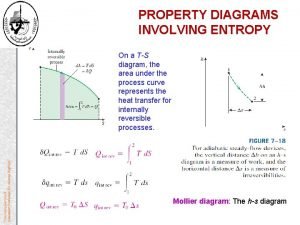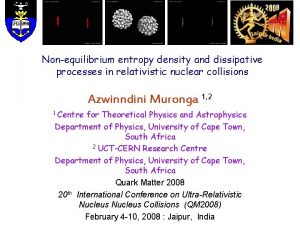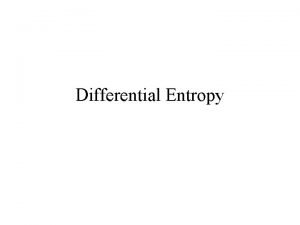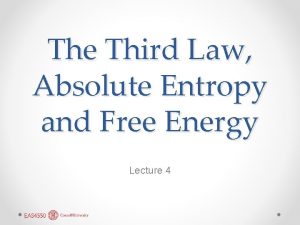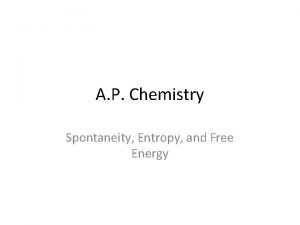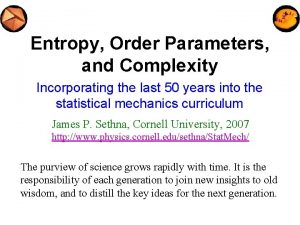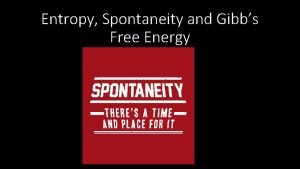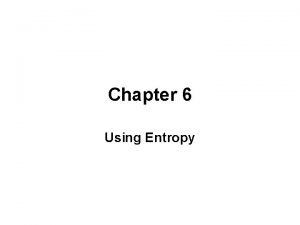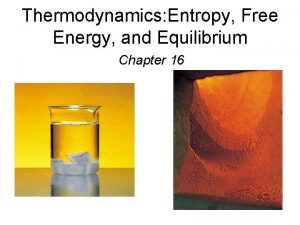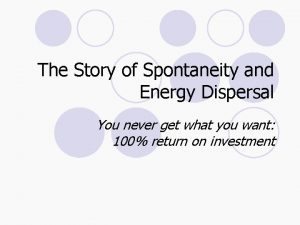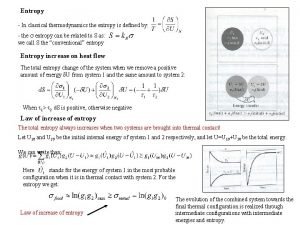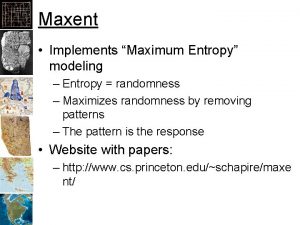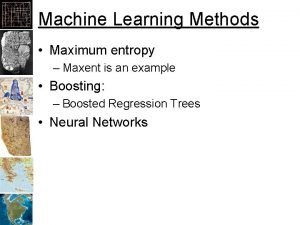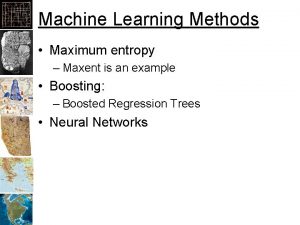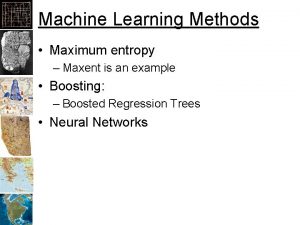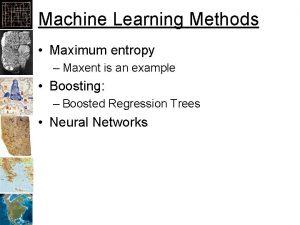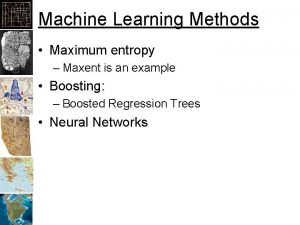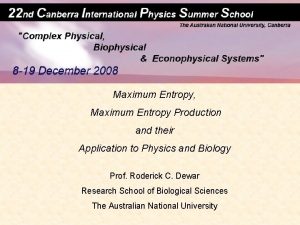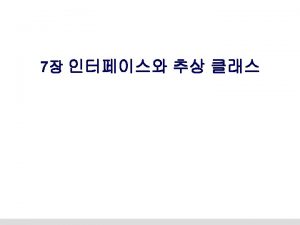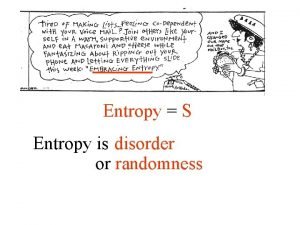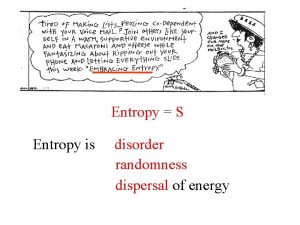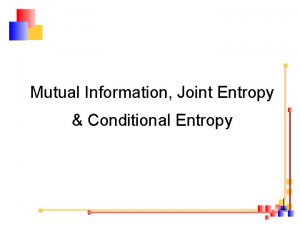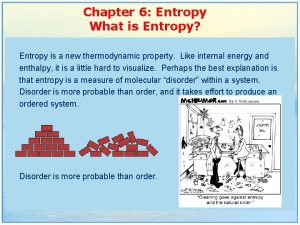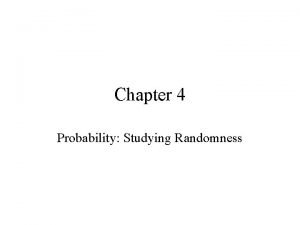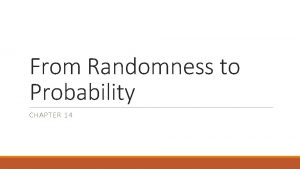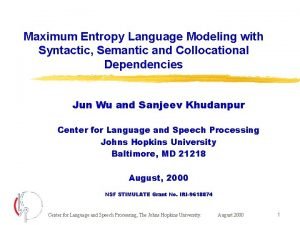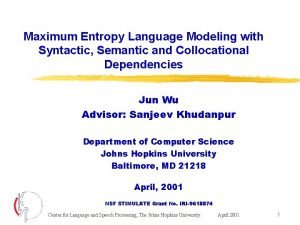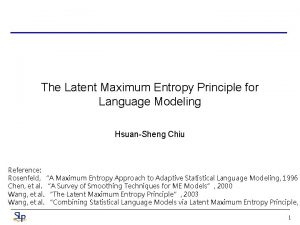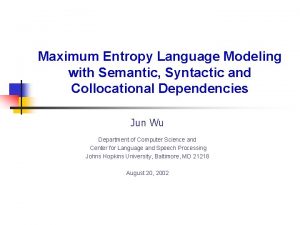Maxent Implements Maximum Entropy modeling Entropy randomness Maximizes














































- Slides: 46

Maxent • Implements “Maximum Entropy” modeling – Entropy = randomness – Maximizes randomness by removing patterns – The pattern is the response • Website with papers: – http: //www. cs. princeton. edu/~schapire/maxe nt/

Overall Definitions • Overall area used to create the model: – Sample area, area-of-interest (AOI), background • Locations where species was observed: – Occurrences, presence points, observations • Environmental predictors: – Covariates, independent variables • Probability density function: – A function showing the probably of values for a covariate – Area under the function must equal 1

Definitions •

Relationships of histograms to probability distributions N Histogram of all covariate values Frequency Histogram of covariate values at occurrences 0 Min Covariate (precip, temp, aspect, distance from…) Max

Densities • 1 Highest density of occurrences (best habitat) No occurrences (not habitat) 0 Min Covariate (precip, temp, aspect, distance from…) Max

Densities From Elith et. al.

Max. Ent’s “Model” •

Max. Ent Optimizes “Gain” • “Gain in Max. Ent is related to deviance” – See Phillips in the tutorial • Max. Ent generates a probability distribution of pixels in the grid starting at uniform and improving the fit to the data • “Gain indicates how closely the model is concentrated around presence samples” – Phillips

Gain •

Regularization •

Background Points • 10, 000 random points (default) • Uses all pixels if <10, 000 samples

Max. Ent really… • Max. Ent tries to create a probability surface in hyperspace where: – Values are near 1. 0 where there are lots of points – Values are near 0. 0 where there are few or no points

Logit – Inverse of Logistic

Synthetic Habitat & Species

Max. Ent Outputs

Threshold~0. 5 Threshold~0. 2 Threshold~0. 0

Cumulative Threshold of 0 = Entire area All points omitted for no area Threshold of 100% = no area No omission for entire area

Definitions • Omission Rate: Proportion of points left out of the predicted area for a threshold • Sensitivity: Proportion of points left in the predicted area – 1 – Omission Rate • Fractional Predicted Area: – Proportion of area within the thresholded area • Specificity: Proportion of area outside thresholded area – 1 – Fractional Predicted Area:

Receiver-Operator Curve (ROC) Area Under The Curve (AUC)

What proportion of the sample points are within the thresholded area Goes up quickly if points are within a sub-set of the overall predictor values What proportion of the total area is within the thresholded area

AUC Area Under the Curve 0. 5=Model is random, Closer to 1. 0 the better

Best Explanation Ever! http: //en. wikipedia. org/wiki/Receiver_operating_characteristic

Fitting Features • Types of “Features” – Threshold: flat response to predictor – Hinge: linear response to predictor – Linear: linear response to predictor – Quadratic: square of the predictor – Product: two predictors multiplied together – Binary: Categorical levels • The following slides are from the tutorial you’ll run in lab

Threshold Features

Linear

Quadratic

Hinge Features

Product Features

Getting the “Best” Model • AUC does not account for the number of parameters – Use the regularization parameter to control over-fitting • Max. Ent will let you know which predictors are explaining the most variance – Use this, and your judgment to reduce the predictors to the minimum number – Then, rerun Max. Ent for final outputs

Number of Parameters cld 6190_ann, 0. 0, 32. 0, 84. 0 dtr 6190_ann, 0. 0, 49. 0, 178. 0 ecoreg, 0. 0, 14. 0 frs 6190_ann, -1. 1498818281061252, 0. 0, 235. 0 h_dem, 0. 0, 5610. 0 pre 6190_ann, 0. 0, 204. 0 pre 6190_l 1, 0. 0, 185. 0 pre 6190_l 10, 0. 0, 250. 0 pre 6190_l 4, 0. 0, 188. 0 pre 6190_l 7, 0. 0, 222. 0 tmn 6190_ann, 0. 0, -110. 0, 229. 0 tmp 6190_ann, 0. 5804254993432195, 1. 0, 282. 0 tmx 6190_ann, 0. 0, 101. 0, 362. 0 vap 6190_ann, 0. 0, 1. 0, 310. 0 tmn 6190_ann^2, 1. 0673168197973097, 0. 0, 52441. 0 tmx 6190_ann^2, -4. 158022614271723, 10201. 0, 131044. 0 vap 6190_ann^2, 0. 8651171091826158, 1. 0, 96100. 0 cld 6190_ann*dtr 6190_ann, 1. 2508669203612586, 2624. 0, 12792. 0 cld 6190_ann*pre 6190_l 7, -1. 174755465148628, 0. 0, 16884. 0 cld 6190_ann*tmx 6190_ann, -0. 4321445358008761, 3888. 0, 28126. 0 cld 6190_ann*vap 6190_ann, -0. 18405049411034943, 38. 0, 25398. 0 dtr 6190_ann*pre 6190_l 1, 1. 1453859981618322, 0. 0, 19240. 0 dtr 6190_ann*pre 6190_l 4, 4. 849148645354156, 0. 0, 18590. 0 dtr 6190_ann*tmn 6190_ann, 3. 794041694656147, -16789. 0, 23843. 0 ecoreg*tmn 6190_ann, 0. 45809862608857377, -1320. 0, 2290. 0 ecoreg*tmx 6190_ann, -1. 6157434815320328, 154. 0, 3828. 0 ecoreg*vap 6190_ann, 0. 34457033151188204, 12. 0, 3100. 0 frs 6190_ann*pre 6190_l 4, 2. 032039282175344, 0. 0, 6278. 0 frs 6190_ann*tmp 6190_ann, -0. 7801709867413774, 0. 0, 15862. 0 frs 6190_ann*vap 6190_ann, -3. 5437330369989097, 0. 0, 11286. 0 h_dem*pre 6190_l 10, 0. 6831004745857797, 0. 0, 332920. 0 h_dem*pre 6190_l 4, -7. 446077252168424, 0. 0, 318591. 0 pre 6190_ann*pre 6190_l 7, 1. 5383313604986337, 0. 0, 39780. 0 pre 6190_l 1*vap 6190_ann, -2. 6305122968909807, 0. 0, 47495. 0 pre 6190_l 10*pre 6190_l 4, -2. 5355630131828004, 0. 0, 47000. 0 pre 6190_l 10*pre 6190_l 7, 5. 413839860312993, 0. 0, 48750. 0 pre 6190_l 10*tmn 6190_ann, 1. 2055688090972252, -1407. 0, 54500. 0 pre 6190_l 4*pre 6190_l 7, -3. 172491547290633, 0. 0, 36660. 0 pre 6190_l 4*tmn 6190_ann, -1. 2333164353879962, -1463. 0, 40984. 0 pre 6190_l 4*vap 6190_ann, -0. 6865648521426311, 0. 0, 55648. 0 pre 6190_l 7*tmp 6190_ann, -0. 45424195658031474, 0. 0, 55278. 0 pre 6190_l 7*tmx 6190_ann, -0. 23195173539212843, 0. 0, 68598. 0 tmn 6190_ann*tmp 6190_ann, 0. 733594398523686, -6300. 0, 64014. 0 tmn 6190_ann*vap 6190_ann, 1. 414888294903485, -3675. 0, 70074. 0 (85. 5<pre 6190_l 10), 0. 7526049605127942, 0. 0, 1. 0 (22. 5<pre 6190_l 7), 0. 09143627960137418, 0. 0, 1. 0 (14. 5<pre 6190_l 7), 0. 3540139414522918, 0. 0, 1. 0 (101. 5<tmn 6190_ann), 0. 5021949716276776, 0. 0, 1. 0 (195. 5<h_dem), -0. 4332023993069761, 0. 0, 1. 0 (340. 5<tmx 6190_ann), -1. 4547597256316012, 0. 0, 1. 0 (48. 5<h_dem), -0. 1182394373335682, 0. 0, 1. 0 (14. 5<pre 6190_l 10), 1. 4894000152716946, 0. 0, 1. 0 (308. 5<tmx 6190_ann), -0. 5743766711031515, 0. 0, 1. 0 (311. 5<tmx 6190_ann), -0. 19418359220467488, 0. 0, 1. 0 (23. 5<pre 6190_l 4), 0. 6810910505907158, 0. 0, 1. 0 (9. 5<ecoreg), 0. 7192087537708799, 0. 0, 1. 0 (281. 5<tmx 6190_ann), -1. 2177451449751997, 0. 0, 1. 0 (50. 5<h_dem), -0. 2041650979073212, 0. 0, 1. 0 'tmn 6190_ann, 2. 506694714713521, 228. 5, 229. 0 (36. 5<h_dem), -0. 04215558381842702, 0. 0, 1. 0 (191. 5<tmp 6190_ann), 0. 8679225073207016, 0. 0, 1. 0 (101. 5<dtr 6190_ann), 0. 0032675586724019226, 0. 0, 1. 0 'cld 6190_ann, -0. 009785185080653264, 82. 5, 84. 0 `h_dem, -1. 0415514779720143, 0. 0, 2. 5 (1367. 0<h_dem), -0. 2128591450282928, 0. 0, 1. 0 (280. 5<tmx 6190_ann), -0. 06975266984609022, 0. 0, 1. 0 (55. 5<pre 6190_ann), -0. 3681568888568664, 0. 0, 1. 0 (211. 5<h_dem), -0. 09946657794871552, 0. 0, 1. 0 (82. 5<pre 6190_l 10), 0. 09831192008677023, 0. 0, 1. 0 (41. 5<pre 6190_l 7), -0. 07282871533190113, 0. 0, 1. 0 (86. 5<pre 6190_l 1), -0. 06404898712746389, 0. 0, 1. 0 (106. 5<pre 6190_l 1), 0. 9347973610811197, 0. 0, 1. 0 (97. 5<pre 6190_l 4), 0. 02588993095745272, 0. 0, 1. 0 `h_dem, 0. 2975112175166992, 0. 0, 57. 5 `pre 6190_l 1, -1. 4918629714740488, 0. 0, 3. 5 (87. 5<pre 6190_l 1), -0. 16210452683985327, 0. 0, 1. 0 `pre 6190_l 1, 0. 6469706380585183, 0. 0, 33. 5 (199. 5<vap 6190_ann), 0. 07974469741688692, 0. 0, 1. 0 `pre 6190_l 7, 0. 6529517367541156, 0. 0, 0. 5 (985. 0<h_dem), 0. 5311126727361561, 0. 0, 1. 0 (12. 5<pre 6190_l 7), 0. 15147093558026073, 0. 0, 1. 0 'dtr 6190_ann, 1. 9102989446786593, 100. 5, 178. 0 (24. 5<pre 6190_l 7), 0. 22066203658397954, 0. 0, 1. 0 `h_dem, 0. 19290062857835738, 0. 0, 58. 5 (95. 5<pre 6190_l 4), 0. 11847374533530691, 0. 0, 1. 0 (42. 5<pre 6190_l 10), -0. 22634502760604264, 0. 0, 1. 0 (59. 5<cld 6190_ann), -0. 08833902526182105, 0. 0, 1. 0 (156. 5<tmn 6190_ann), -0. 3949178282642713, 0. 0, 1. 0 'vap 6190_ann, -0. 09749601885757717, 284. 5, 310. 0 (195. 5<pre 6190_l 10), -0. 7064287716566797, 0. 0, 1. 0 'pre 6190_ann, -0. 13355287707153143, 198. 5, 204. 0 (85. 5<pre 6190_ann), -0. 08639349917230135, 0. 0, 1. 0 `cld 6190_ann, -0. 8869579099922708, 32. 0, 56. 5 (127. 5<pre 6190_l 7), 0. 16433984792079512, 0. 0, 1. 0 (310. 5<tmx 6190_ann), -0. 12187855649464616, 0. 0, 1. 0 (123. 5<dtr 6190_ann), -0. 3879778631592106, 0. 0, 1. 0 (58. 5<cld 6190_ann), -0. 045757294470318455, 0. 0, 1. 0 `h_dem, -0. 03506780995851361, 0. 0, 15. 5 `dtr 6190_ann, 0. 8788733700181052, 49. 0, 89. 5 (34. 5<pre 6190_ann), -0. 11675983810645604, 0. 0, 1. 0 `h_dem, -0. 07042193156800028, 0. 0, 16. 5 (195. 5<tmp 6190_ann), -0. 06201919461360444, 0. 0, 1. 0 linear. Predictor. Normalizer, 8. 791343644655978 density. Normalizer, 129. 41735442727088 num. Background. Points, 10112 entropy, 7. 845994051976282

Running Maxent • Folder for layers: – Must be in ASCII Grid “. asc” format • CSV file for samples: – Must be: Species, X, Y • Folder for outputs: – Maxent will put a number of files here

Avoiding Problems • Create a folder for each modeling exercise. – Add a sub-folder for “Layers” • Layers must have the same extent & number of rows and columns of pixels – Save your samples to a CSV file: • Species, X, Y as columns – Add a sub-folder for each “Output”. • Number or rename for each run • Some points may be missing environmental data

Running Maxent • Batch file: – maxent. bat contents: • java -mx 512 m -jar maxent. jar – The 512 sets the maximum RAM for Java to use • Double-click on jar file – Works, with default memory

Maxent GUI

Douglas-Fir Points

AUC Curve

Response Curves Each response if all predictors are used Each response if only one predictor is used

Surface Output Formats •


Percent Contribution • Precip. contributes the most

Settings

Regularization = 2 • AUC = 0. 9

Resampling Occurrences • Max. Ent Uses: – Leave-one-out cross-validation (LOOCV) • Break up data set into N “chucks”, run model leaving out each chunk • Replication: Max. Ent’s term for resampling

Optimizing Your Model • Select the “Sample Area” carefully • Use “Percent Contribution”, Jackknife and correlation stats to determine the set of “best” covariates • Try different regularization parameters to obtain response curves you are comfortable with and reduce the number of parameters (and/or remove features) • Run “replication” to determine how robust the model is to your data

Model Optimization & Selection • • Modeling approach Predictor Selection Coefficients estimation Validation: – Against sub-sample of data – Against new dataset • Parameter sensitivity • Uncertainty estimation

Linear GAM BRT Maxent Number of predictors N N “Base” equation Linear (or linearized) Link + splines (typical) Trees Linear, product, threshold, etc. Fitting approach Direct analytic solution Solve derivative for maximum likelihood Make a tree, add one, if better, keep going Search for best solution Response variable Continuous or categorical Presence-only Covariates Continuous or categorical Uniform residuals Yes Yes Independent samples Yes Yes Complexity Simple Moderate Complex Over fit No Unlikely Probably
 Maxent.bat
Maxent.bat Entropy vs enthalpy
Entropy vs enthalpy Maximum likelihood vs maximum parsimony
Maximum likelihood vs maximum parsimony Local maximum
Local maximum Maximum parsimony vs maximum likelihood
Maximum parsimony vs maximum likelihood Helen erickson nursing theory
Helen erickson nursing theory Dimensional modeling vs relational modeling
Dimensional modeling vs relational modeling Randomness in architecture
Randomness in architecture Chapter 14 randomness and probability
Chapter 14 randomness and probability Randomness probability and simulation
Randomness probability and simulation Ap stats chapter 10 understanding randomness
Ap stats chapter 10 understanding randomness A measure of the randomness in a system
A measure of the randomness in a system Randomness probability and simulation
Randomness probability and simulation Structure and randomness
Structure and randomness Randomness probability and simulation
Randomness probability and simulation Sami sahnoune
Sami sahnoune Randomness probability and simulation
Randomness probability and simulation Run test for randomness example
Run test for randomness example Randomness probability and simulation
Randomness probability and simulation Chi square test for randomness
Chi square test for randomness Chapter 14 from randomness to probability
Chapter 14 from randomness to probability Ap statistics chapter 13 from randomness to probability
Ap statistics chapter 13 from randomness to probability Mimi opkins
Mimi opkins Soal d
Soal d Effleurage definition milady
Effleurage definition milady Types of exception in java
Types of exception in java What are universal precautions in cosmetology
What are universal precautions in cosmetology Extends jframe implements actionlistener
Extends jframe implements actionlistener Sqlite is an in-process library that implements a
Sqlite is an in-process library that implements a Extends class
Extends class Implements comparable
Implements comparable Differentiate between primary and secondary tillage
Differentiate between primary and secondary tillage A manual calculator implements algorithms autonomously.
A manual calculator implements algorithms autonomously. Uml java interface
Uml java interface Huffman coding entropy
Huffman coding entropy Entropy change in isothermal process
Entropy change in isothermal process Entropy thermodynamics
Entropy thermodynamics Entropy
Entropy Differential entropy
Differential entropy Absolute entropy
Absolute entropy Ap chemistry entropy and free energy
Ap chemistry entropy and free energy Entropy order parameters and complexity
Entropy order parameters and complexity Entropy
Entropy Constant entropy
Constant entropy Law of entropy
Law of entropy Entropy
Entropy What is entropy in thermodynamics
What is entropy in thermodynamics
